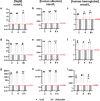Negligible In Vitro Recovery of Macromolecules from Microdialysis Using 100 kDa Probes and Dextran in Perfusion Fluid
- PMID: 38478218
- PMCID: PMC10991005
- DOI: 10.1007/s11064-024-04119-7
Negligible In Vitro Recovery of Macromolecules from Microdialysis Using 100 kDa Probes and Dextran in Perfusion Fluid
Abstract
Microdialysis is applied in neurointensive care to monitor cerebral glucose metabolism. If recoverable, macromolecules may also serve as biomarkers in brain disease and provide clues to their passage across the blood-brain barrier. Our study aimed to investigate the in vitro recovery of human micro- and macromolecules using microdialysis catheters and perfusion fluids approved for clinical use. In vitro microdialysis of a bulk solution containing physiological or supraphysiological concentrations of glucose, lactate, pyruvate, human IgG, serum albumin, and hemoglobin was performed using two different catheters and perfusion fluids. One had a membrane cut-off of 20 kDa and was used with a standard CNS perfusion fluid, and the other had a membrane cut-off of 100 kDa and was perfused with the same solution supplemented with dextran. The flow rate was 0.3 µl/min. We used both push and push-pull methods. Dialysate samples were collected at 2-h intervals for 6 h and analyzed for relative recovery of each substance. The mean relative recovery of glucose, pyruvate, and lactate was > 90% in all but two sets of experiments. In contrast, the relative recovery of human IgG, serum albumin, and hemoglobin from both bulk solutions was below the lower limit of quantification (LLOQ). Using a push-pull method, recovery of human IgG, serum albumin, and hemoglobin from a bulk solution with supraphysiological concentrations were above LLOQ but with low relative recovery (range 0.9%-1.6%). In summary, exchanging the microdialysis setup from a 20 kDa catheter with a standard perfusion fluid for a 100 kDa catheter with a perfusion solution containing dextran did not affect the relative recovery of glucose and its metabolites. However, it did not result in any useful recovery of the investigated macromolecules at physiological levels, either with or without a push-pull pump system.
Keywords: Dextran; In vitro; Macromolecules; Microdialysis.
© 2024. The Author(s).
Conflict of interest statement
The authors report no competing interests.
Figures



References
-
- Yang DY, Tsai TH, Cheng CH, Lee CW, Chen SH, Cheng FC. Simultaneous monitoring of extracellular glucose, pyruvate, lactate and glutamate in gerbil cortex during focal cerebral ischemia by dual probe microdialysis. J Chromatogr A. 2001;913(1–2):349–354. doi: 10.1016/S0021-9673(00)01033-5. - DOI - PubMed
MeSH terms
Substances
LinkOut - more resources
Full Text Sources
Research Materials

